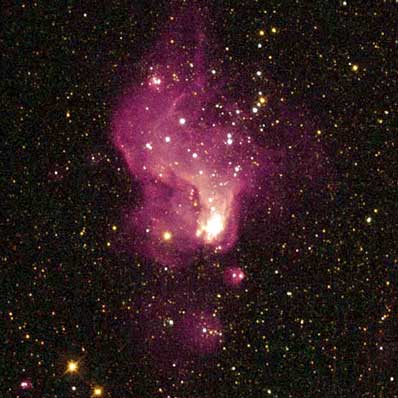
A giant star factory in neighboring galaxy
SPACE TELESCOPE SCIENCE INSTITUTE NEWS RELEASE
Posted: December 7, 2001

Galaxy NGC 6822. Credits: NASA, ESA, and The Hubble Heritage Team (STScI/AURA)
Acknowledgment: C. R. O'Dell (Vanderbilt University) and L. Bianchi (Johns Hopkins University and Osservatorio Astronomico, Torinese, Italy)
|
Resembling curling flames from a campfire, this magnificent
nebula in a neighboring galaxy is giving astronomers new insight
into the fierce birth of stars as it may have more commonly
happened in the early universe. The glowing gas cloud, called
Hubble-V, has a diameter of about 200 light-years. A faint tail
of nebulosity trailing off the top of the image sits opposite a
dense cluster of bright stars at the bottom of the irregularly
shaped nebula. NASA's Hubble Space Telescope's resolution and
ultraviolet sensitivity reveals a dense knot of dozens of ultra-hot
stars nestled in the nebula, each glowing 100,000 times brighter
than our Sun. These youthful 4-million-year-old stars are too
distant and crowded together to be resolved from ground-based
telescopes. The small, irregular host galaxy, called NGC 6822,
is one of the Milky Way's closest neighbors and is considered
prototypical of the earliest fragmentary galaxies that inhabited
the young universe. The galaxy is 1.6 million light-years away in
the constellation Sagittarius.
The Hubble-V image data was taken with Hubble's Wide Field
Planetary Camera 2 (WFPC2) by two science teams: C. Robert O'Dell
of Vanderbilt University and collaborators, and Luciana Bianchi
of Johns Hopkins University and Osservatorio Astronomico, Torinese,
Italy, and collaborators. This color image was produced by The
Hubble Heritage Team (STScI). A Hubble image of Hubble-X, another
intense star-forming region in NGC 6822, was released by The
Heritage Team in January 2001.

|
 |
 |
 |



|

